Sphinginae subfamily
Sphingini Tribe:
 |
Note the pinkish-orange tail, spiracles outlined in red and the cream
stripes on the head.
The dramatic color change from the dorsal
yellow-green to the lateral light greyish-blue is not always
as intense as in this image.
|
 |
Larvae hide in the day and feed primarily on cherry, plum, and apple
at night. Larvae have been found on Amelanchier nantuckensis
in Massachusetts and have been reared to pupation in Michigan on
Prunus serotina. Note purple oblique lines.
|
 |
Larval hosts are apple (Malus), sweetfern (Myrica),
Carolina rose (Rosa carolina), blueberry and huckleberry
(Vaccinium), white spruce (Picea glauca), American
larch (Larix laricina), and alder (Alnus).
|
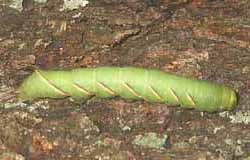 |
Sphinx luscitiosa
WO,
the Canadian Sphinx or
Clemen's Sphinx
This one is reported from Richmond and from northeastern New
Jersey into southern Canada.
|
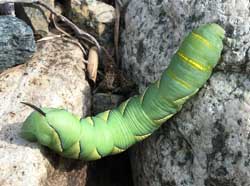 |
Sphinx vashti
BAMONA,
the Snowberry Sphinx
Larvae feed on the common snowberry (Symphoricarpos albus)
and on coralberry (S. orbiculatus). Note the two golden
lines of slightly raised bumps, one just behind the head, the other
on the thorax.
|
Smerinthini Tribe:
 |
Pachysphinx modesta
BAMONA,
the Modest Sphinx or Poplar Sphinx
It is fond of poplars and willows.
|
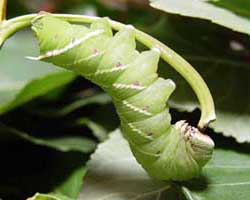 |
Larvae feed on cottonwood and poplar (Populus) and willow
(Salix).
Larvae are very chunky with little to distinguish them
from Pachysphinx modesta.
|
 |
Larvae accept willows, birches, and cherries.
I have also found them in the wild on oak in eastern Canada.
|
 |
Paonias myops
BAMONA, the Small-eyed Sphinx
Wild cherry species are the favorites as larval foodplants, but eggs
will also be deposited on birches and other forest trees.
There are varying degrees in the amount of red markings along the sides.
|
 |
Smerinthus cerisyi
BAMONA,
Cerisy's Sphinx;
Cerisyi larvae are pale
green, with granular skin, pale lateral diagonal lines, faint red
spiracular circles, and very pale longitudinal lines running from
head to more pronounced anal diagonal line.
Larvae have green heads bounded dorsally with pale yellow
inverted "V".
|
 |
Smerinthus jamaicensis
BAMONA,
the Twin-spotted Sphinx:
Larvae feed upon many forest trees including birches and cherries,
but are expecially fond of poplars and willows. Red markings on sides
vary greatly from specimen to specimen.
|
Macroglossinae subfamily
Dilophonotini Tribe
 |
Hemaris diffinis
WO,
Snowberry Clearwing or Bumblebee Moth:
Larval host plants include Snowberry (Symphoricarpos),
honeysuckle (Lonicera), Coralberry, viburnums, Blue Dogbane
(Apocynum), dwarf bush honeysuckle (Diervilla lonicera).
Horn: black with yellow base.
|
 |
Hemaris thysbe
WO, the Hummingbird Clearwing
There is also an orangey-pink prepupal form. The lateral line runs
from S1 to the blue horn.
Hemaris thysbe larvae feed on viburnum and related plants.
|
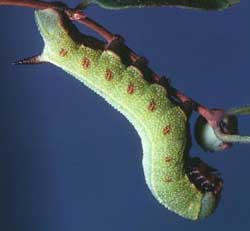 |
Larval host plants include Snowberry (Symphoricarpos),
honeysuckle (Lonicera), Coralberry, viburnums, high bush cranberry and hawthorn (Crataegus).
Horn is black with a slightly lighter base. This western species was formerly classified as
H. diffinis or H. senta. Those species west of the Continental Divide are now classified as
H. thetis.
|
Philampelini Tribe:
 |
Larvae feed upon Grape (Vitis), Virginia Creeper
(Parthenocissus quinquefolia) and other vines and ivies
(Ampelopsis).
Larvae occur in both a light (green) form and a darker (tan/brown)
form. Note six "segmented" oblique lines.
|
Macroglossini Tribe
 |
Hyles gallii
WO, the Bedstraw Hawk Moth
or Gallium Sphinx
Larvae come in black and in brown forms and often feed on
Epilobium (fireweed).
|
 |
Hyles lineata
BAMONA, the White-lined Sphinx
Larvae are highly varied and feed on a great diversity of plants
including willow weed (Epilobium), four o'clock (Mirabilis),
apple (Malus), evening primrose (Oenothera), elm
(Ulmus), grape (Vitis), tomato (Lycopersicon),
purslane (Portulaca), and Fuschia.
All larvae seem, however, to have the red/black swellings split by
dorso-lateral lines.
|
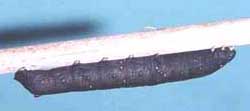 |
Larvae feed on willow weed (Epilobium) and possibly thimbleberry (Rubus parviflorus).
|
|
|
